Commentary by Alan J. Pakula
A New Yorker out of Yale, Alan J. Pakula became a production apprentice at MGM in 1950, later moving to Paramount, where he became a producing partner with director Robert Mulligan. The pair turned out a series of distinguished films including Fear Strikes Out (1957), To Kill a Mockingbird (1962), Love with the Proper Stranger (1963), Baby the Rain Must Fall (1965), Inside Daisy Clover (1965), and Up the Down Staircase (1967).
Pakula turned to directing with The Sterile Cuckoo (1969), featuring Liza Minnelli in her first starring role. He followed with Klute (1971), for which Jane Fonda won an Oscar, The Parallax View (1974), Sophie’s Choice (1982), another Oscar for Meryl Streep, and Presumed Innocent (1990), among others. He died in 1998.
In early 1975, Robert Redford asked Pakula, with whom he had worked with on Inside Daisy Clover, about directing All the President’s Men, the story of how The Washington Post reporters Bob Woodward and Carl Bernstein cracked the Watergate story and brought down President Nixon. At the time, Pakula was busy on another project with Universal, but Redford tried him again two months later. “You called at a good time,” said Pakula. “I’ve run into budget problems at Universal. Let’s talk.”
Pakula spent weeks in the Post newsroom, as did Redford and co-star Dustin Hoffman, to prepare for the film. “All three of us wanted to be thoroughly immersed in that world,” said Pakula. “But once Dustin and Bob got the feeling for it, they had to create a world of their own. We couldn’t just do an imitation of the figures of Watergate. Otherwise we would have ended up with waxworks.”
The producer of All the President’s Men was Walter Coblenz, who joined the Directors Guild as a stage manager in 1960. “Walter was dedicated to the production from beginning to end,” said Pakula. “He was totally knowledgeable about production matters, and also had a continuing taste and an appreciation for all the problems.” Bill Green and Art Levinson were 1st assistant directors. “All were tremendously supportive,” said Pakula, who was nominated for a DGA Award. All the President’s Men is a film that has had a lasting impact on the world of American politics.
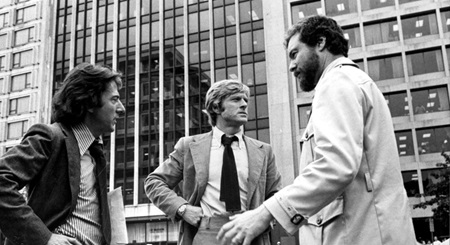
The three of us shared a sense of obsession. Bob and Dustin are the kind of actors I like to work with most. Both of them leave room for the other actor. Some actors come to the set ready to do their parts a certain way, no matter how the other actor plays the scene. Bob and Dustin listen to each other and react accordingly. If Bob changed a reading, Dustin altered his delivery to fit the change, and vice versa. That’s how life comes into a scene.
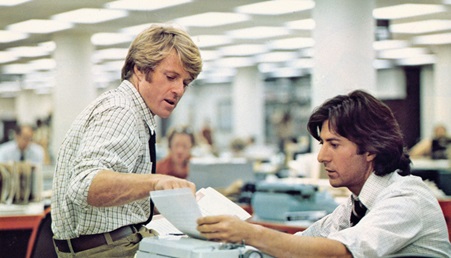
I had a frightening feeling of déjà vu when I saw our set for the first time. [Production designer George] Jenkins had done such a terrific job—even having the Post’s trash shipped out—that I knew any phony behavior would look twice as phony on this set. Photographically it was ideal. The Post had moved into its new building six months before Watergate started, and the interior was a hard, fluorescent world without shadows. I shot quite a bit from below to show the infinity of ceiling lights. Everything is ruthlessly exposed in that light. That contrasted with the shadowy world that Woodward and Bernstein were investigating outside
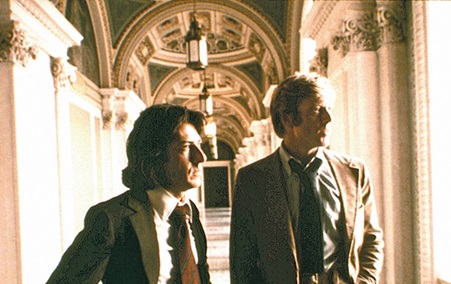
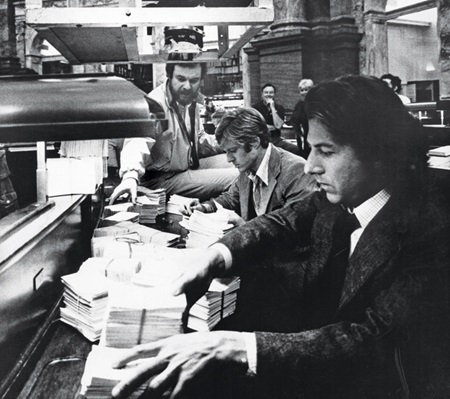
When I was in Washington looking for locations, I saw the Library of Congress and immediately said, ‘Yes.’ I loved the idea of Woodward and Bernstein in this huge place looking for a small slip of paper that would add another link to the Watergate story—proving that E. Howard Hunt had withdrawn articles about Ted Kennedy and Chappaquiddick. I also liked the background of a pseudo-Renaissance building, recalling the glories of man’s achievements, as a locale for the search into the pettiest and meanest acts committed by people in politics.
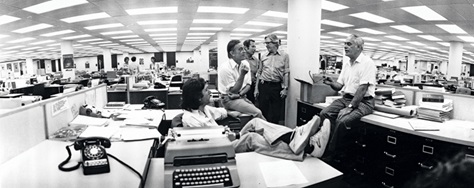
Early on, Bob Redford had the dream of actually filming in the Post newsroom. That was impractical, since we could have shot only from 3 a.m. to 6 a.m. I think it was wise not to. When we came to Burbank and worked in the newsroom recreated by production designer Jenkins (second from right), then it was our newsroom, our Post. When the editor of The Post Ben Bradlee (second from left) visited us, it was as a tourist, not as editor in his own domain. (also in photo, from left: Dustin Hoffman, Walter Coblenz, Martin Balsam).
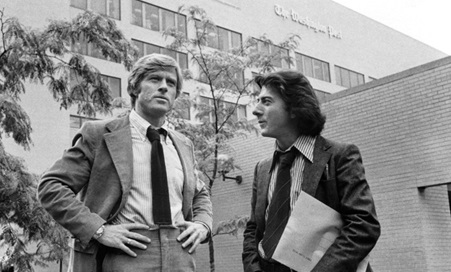
The attitude of The Washington Post toward our project was ambivalent, as mine would have been in the same situation. The people in charge didn’t want to make it seem they were gloating, calling attention to their achievements, reaching for publicity. Once they realized the picture was going to be made and they had no control, they decided it was best to cooperate so there would be as much reality as possible. They watched the project with hope, fear and trepidation. But then, a newspaper could hardly claim the right to privacy.
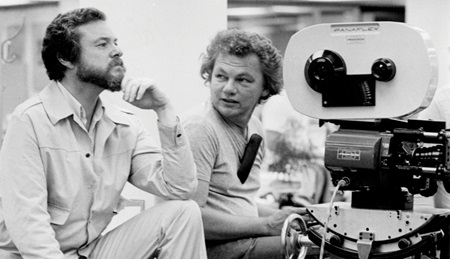
My cinematographer, Gordon Willis, faced endless problems in order to keep both the foreground and the background action in focus. I wanted that look of various levels of activity going on at the same time. Gordon is ideal to work with because he makes each picture look different. And he always remembers your initial concept of what you visualized in the film. Whenever I strayed from that concept, he reminded me of it. Even when he could do work that might be showier, he wouldn’t allow himself to do so.
I filmed many of the scenes with a backdrop of government buildings, aiming for that effect of two men against enormous blocks of granite, a kind of David vs. Goliath. Note the trams on the street: Universal Studios runs Washington tours. You can’t get away from it.
Directors have a tendency to use their hands like orchestra conductors. They don’t realize that the actor is looking at their faces, anyway. It’s sad that Dustin never worked for William Wyler; he would have wanted more takes than Willy. Like any talented person, Dustin is obsessive, and he is always finding new things
My idea was to start the picture with no camera movement—just people sitting at telephones doing their work. Then the camera starts to move as the people become more manic, the action becomes more intense. Finally, at the end I did the longest move of the picture, a race by Redford and Hoffman the complete length of the newsroom. In a picture with so many words there is a tendency to over-use the camera. I tried not to.
Bob Redford was in the difficult position of being both producer and star, but during filming there was never any question that the director was in charge. Bob has much more range than people give him credit for. He did one scene for me that was remarkable—a six-minute telephone shot in which I started with a close-up. He had to show with his face that concentration and thought process as he tracked down the story. I think he could do [Eugene] O’Neill, or anything
Jack Warden (left), Jason Robards (center) and Martin Balsam (right) had worked together in New York, so they easily transferred their camaraderie to their roles—but were able to portray men with basic differences. The Bradlee role was difficult to cast. As editor of the Post he needed to have authority and control over reporters Hoffman and Redford—difficult to do with two of the biggest stars in films. Fortunately, Robards had the great respect of Hoffman and Redford as an actor.